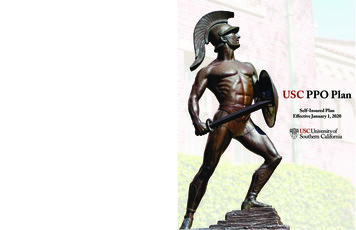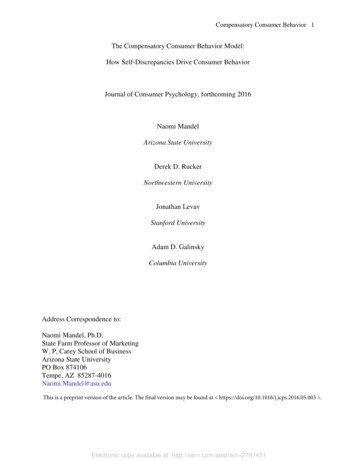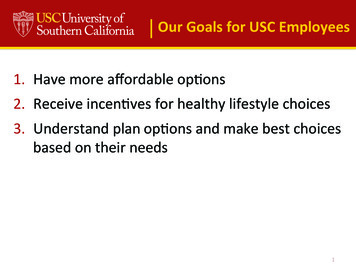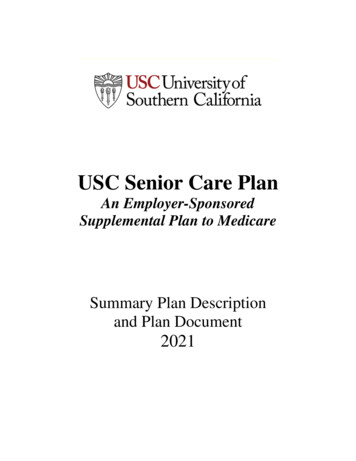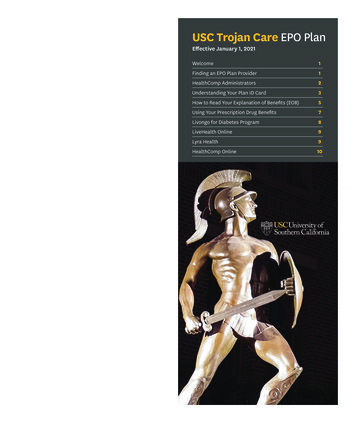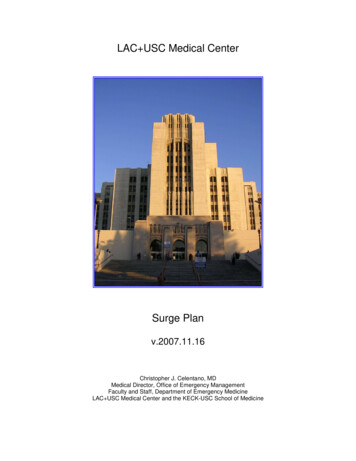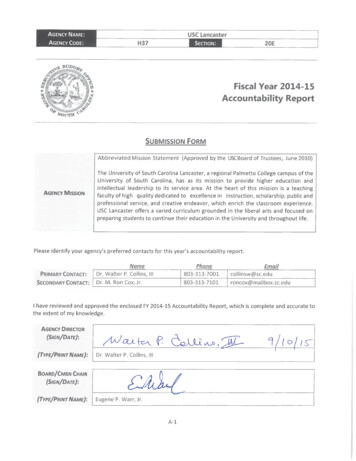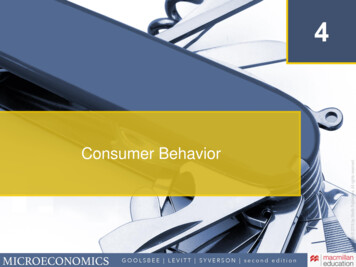
Transcription
4Consumer Behavior
IntroductionChapter Outline4.1The Consumer’s Preferences and the Concept of Utility4.2Indifference Curves4.3The Consumer’s Income and the Budget Constraint4.4Combining Utility, Income, and Prices:What Will the Consumer Consume?4.5Conclusion4
Introduction4How do consumers make purchases? This chapter introduces a theory of consumer behavior The theory is used to investigate why consumers makepurchases Ultimately, consumers are assumed to “optimize” theirutility given scarce resources Consumer theory is the basis for the “demand” side of thesupply and demand model
The Consumer’s Preferences andthe Concept of Utility4.1Economists assume consumers are rational and able to “optimize”consumption decisions given scarce resourcesFour assumptions about consumer preferences1. Completeness and rankability Consumers can compare bundles of goods and rank them2. For most goods, more is better than less Non-satiation and “free disposal”3. Transitivity Imposes consistency on rankings4. The more a consumer has of a particular good, the less she iswilling to give up of something else to get even more of that good Referred to as “diminishing marginal utility”
The Consumer’s Preferences andthe Concept of UtilityThe Concept of UtilityUtility is a measure of how “satisfied” consumers are A measure of happiness or satisfaction Provides a theoretical basis for decision theoryA utility function describes the relationship between whatconsumers actually consume and their level of well-being Can take a variety of mathematical forms Common assumptions: continuous, differentiable, concave4.1
The Consumer’s Preferences andthe Concept of Utility4.1The Concept of UtilityConsider the utility someone enjoys from seeing a movie in a theater vs.watching a DVDU U (T, D)where T is the number of movies “consumed” at the theater, and D isthe number of DVDs consumed at home. Utility might be represented byU T 0.8 D0.2In general, movies consumed in the theater add more utility than thoseconsumed at home* this particular functional form is referred to as “Cobb–Douglas”
The Consumer’s Preferences andthe Concept of Utility4.1The Concept of UtilityMarginal utility is the additional utility a consumer receives froman additional unit of a good or service.
The Consumer’s Preferences andthe Concept of Utility4.1The Concept of UtilityContinuing the previous example, the marginal utility of theater-moviesfor this consumer is given byDU (T, D) dU (T, D)MUT DTdTor, with the prescribed parametersMUT 0.8T -0.2 D0.2
The Consumer’s Preferences andthe Concept of Utility4.1Comparing Consumption OutcomesThe “rules” for utility allows only for an ordinal ranking ofconsumption bundles An ordinal ranking implies bundles can be ranked from best to worse A cardinal ranking would allow a person to determine how muchbetter one bundle is, compared to anotherWhy not cardinal? Many questions can be answered with only an ordinal ranking– Ex: Predicting what will be consumed Consumers differ in preferences‒ Ex: Both between consumers and over time
Indifference Curves4.2Ordinal rankings mean we care about relative outcomes Some bundles are better than others, some are worse Start by considering bundles that are relatively equalA consumer is indifferent between bundles when he or shederives the same utility level from two or more bundles.An indifference curve plots out all of the consumptionbundles that provide a consumer with the same level ofutility or satisfaction.
4.2Indifference CurvesFigure 4.1 Building an Indifference CurveNumberof friendsliving inbuilding10AB5C30Indifferencecurve (U)5007501,000Apartment size (square feet)
Indifference Curves4.2Characteristics of Indifference Curves1. They can be drawn Completeness and rankability2. Curves further from the origin represent higher utility More is better3. Curves never cross Transitivity4. Convex to the origin Diminishing marginal utility
4.2Indifference CurvesFigure 4.2 A Consumer’s Indifference CurvesNumberof friendsliving inbuildingU2 has agreater utilitythan U15U2U105001,000Apartment size (square feet)
4.2Indifference CurvesIndifference curves can never crossCall our movie watcher, JoeMovies at theTheaterTo see why indifference curves cannot cross,consider bundles D and F These bundles are on the same indifferencecurve, therefore Joe must be indifferent betweenthemFENow, draw another indifference curve throughbundle F that intersects the original curve Implies Joe is also indifferent between points Eand F as well as between points E and DDDVDs Why must Joe prefer bundle E to bundle D?‒ If more is better, at E he has more ofboth
4.2Indifference CurvesFigure 4.4 Tradeoffs Along an Indifference CurveAs apartment size gets larger, Michaelais less willing to trade off the numberof friends for additional apartment size.Numberof friendsliving inbuildingA5BU105001,000Apartment size (square feet)
4.2Indifference CurvesThe Marginal Rate of SubstitutionIndifference curves describe tradeoffs How much of one good you are willing to give up for one more unit ofanother good The slope of the indifference curve captures this tradeoffWe call this slope the marginal rate of substitutionMRS XY Y XDescribes the rate at which one is willing to trade off or substituteexactly 1 unit of good X for more of good Y, and be equally welloff.
4.2Indifference CurvesFigure 4.5 The Slope of an Indifference Curve is theMarginal Rate of SubstitutionBurritosAs you move down an indifferencecurve, you experience a diminishingmarginal rate of substitutionASlope –2BSlope –0.5ULattes
4.2Indifference CurvesThe Marginal Rate of Substitution and Marginal UtilityConsider point A from the previous figureMRS XY Qburritos Y 2 X QlattesSarah is willing to give up one latte (X) to gain two burritos (Y), vice versa;What does this mean in terms of the change in Sarah’s level of utility? U MU lattes Qlattes MU burritos Qburritos 0The change in utility is zero. she is just as well off! Rearranging, MU burritos Qburritos MU lattes Qlattesand finally: MRS XY QburritosMU lattes QlattesMU burritos
4.2Indifference CurvesThe Marginal Rate of Substitution and Marginal UtilityThe MRS between two goods is equal to the inverse of the goods’marginal utilities:MRSlb QburritosMU lattes QlattesMU burritosor MRS XY QY MU X QX MU YObserving the tradeoffs that consumers make provides insight as to therelative marginal utilities of goods!What does it mean if the slope of an indifference curve is steeper?Flatter? Steeper curves imply the consumer is willing to give up a lot of Y to get oneunit of X, or could trade 1 unit of X for a lot of good YFlatter curves imply the consumer would require a large increase in good Xto give up one unit of the good Y, or could trade 1 unit of Y for a lot of good X
Indifference Curves4.2Figure 4.6 The Steepness of Indifference Curves
Indifference Curves4.2The Curvature of Indifference Curves: Substitutes and ComplementsThe shape of indifference curves reveals information about the relationshipbetween products Relatively straight indifference curves describe goods that are more easilysubstitutable for one anotherIndifference curves that are more convex to the origin describe goods that aremore complementary to one anotherTo illustrate, consider extreme casesi.Perfect substitutes are goods that the consumer will trade at a fixed rate andreceive the same level of utility (MRS is constant)ii. Perfect complements are goods that the consumer must consume in a fixedproportion
4.2Indifference CurvesPerfect substitutes2-liter bottles ofroot beerConsider a typical consumer’spreferences for 1- and 2-liter soda bottles4This consumer should be willing to tradeone 2-liter bottle for two 1-liter bottles nomatter how much of each he or she has32MRS is constant in this case10U1U2U3U424681-liter bottles ofroot beer
Indifference Curves4.2Perfect complementsAlternatively, consider preferences forhotdogs and hotdog bunsHotdogsC3A2B10U3U223Consider point A ; this consumer has twohotdogs and two bunsAdding another hotdog bun (bundle B )will not increase utilityU11Most consumers will prefer to consumethese goods in constant proportionHotdog bunsThe consumer needs another hotdog aswell (bundle C ) if utility is to increase
Indifference Curves4.2Figure 4.8 The Curvature of Indifference Curves
Indifference Curves4.2Figure 4.11 The Same Consumer Can Have IndifferenceCurves with Different ShapesInitially, for low levels of utility(UA), bananas and strawberriesmight be substitutes.As utility increases (UB), theconsumer might prefer a varietyof fruit in their diet more thaninitially.
The Consumer’s Income and theBudget Constraint4.3The budget constraint is a curve that describes the entire set ofconsumption bundles a consumer can purchase when spending all oftheir income. It is generally plotted alongside indifference curves. For two goods (X and Y), mathematically:Income PX Q X PY QYTo find the slope of the budget constraint, solve for QYIncome PX QxPYPYReturning to the burrito/latte example, and setting income to 50, theprice of lattes to 5, and the price of burritos to 10 yieldsQY Or, graphically,1QY 5 Q X2
The Consumer’s Income and theBudget Constraint4.3Figure 4.14 The Budget ConstraintBurritosBI 5Py4Slope is negative becausepurchasing more lattes meansless income for Burritos.InfeasibleC32Slope FeasiblePx 5/10 1/2Py1A02468I 10 LattesPxWhy does thebudget constraintslope downward?
The Consumer’s Income and theBudget Constraint4.3Factors that Affect the Budget Constraint’s PositionThe slope and position of the budget constraint are a function of twofactors: income and relative prices1. Changes in income shifts the budget constraint by changing the intercepts2. Changes in the price of one good pivots the budget constraint by changingthe slopeConsider again the budget constraint for burritos and lattes. The graphson the next slide represent the following changes:(a) Doubling of the Price of Lattes(b) Doubling of the Price of Burritos(c) Reduction in Income by 1/2
The Consumer’s Income and theBudget Constraint4.3Figure 4.15 The Effects of Price or Income Changes on theBudget Constraint(a)Burritos5B5New budgetconstraint with higherprice for lattes3Loss of feasiblebundles20BurritosOld budgetconstraint41(b)243A'4A6810LattesOld budgetconstraintNew budgetconstraint with higherprice for burritosB'Loss of ew budgetconstraint withlower incomeB'Loss of feasiblebundles2A4Old lebundles2A'4A6810Lattes
The Consumer’s Income and theBudget Constraint4.3Nonstandard Budget ConstraintsQuantity discounts Sometimes, consumers may secure a discounted price if a minimum quantity ofa good is purchased (e.g., buy two, get one free)This results in a kink in the budget constraintEx: Income 100; Ppizza 10 and Pminute 0.10 Initially, the consumer could consume 10 pizzas or 1,000 phone minutes if spentall of their income on either product; Result is normal linear budget constraint‒ Introduce a quantity discount of .05 per minute for every minute used over 600‒ Result is a kink at 600 minute (and 4 pizzas) because every minute over 600now only costs 0.05 compared to 0.10 originally Graphically,
The Consumer’s Income and theBudget Constraint4.3Figure 4.16 Quantity Discounts and the Budget ConstraintPhoneminutes1,4005 cents/minute1,000Feasible600Infeasible10 cents/minuteFeasible0410Pizzas
The Consumer’s Income and theBudget Constraint4.3Nonstandard Budget ConstraintsQuantity limits Alternatively, there may be limits on how much of a good can be purchased(e.g., gasoline in the 1970s)Ex: Income 100; Ppizza 10 and Pminute 0.10 Now, instead of a discount after 600 minutes the phone company puts a capat 600 minutes so his phone will not work after the 600th minute‒ Result is a kink in the opposite direction as before at 600 minutes Graphically,
The Consumer’s Income and theBudget Constraint4.3Figure 4.17 Quantity Limits and the Budget Constraint
Combining Utility, Income, and Prices:What Will the Consumer Consume?4.4The concepts of utility and indifference curves describe consumerpreferences; the budget constraint describes which bundles are feasibleCombining these concepts, we can begin to understand consumerchoicesSolving the Consumer’s Optimization ProblemConsumers face a constrained optimization problem Maximize utility, subject to income and market pricesThe optimal choice can be interpreted most easily using a graph
Combining Utility, Income, and Prices:What Will the Consumer Consume?Utility MaximizationGood YWith one budget constraint,search for indifference curvethat maximizes utilityAU2U*U1BC*Good X4.4
Combining Utility, Income, and Prices:What Will the Consumer Consume?4.4Tangency is the key to finding the optimal bundle, and occurs where the slope of the indifference curve is equal to the slope of the budgetconstraint‒ i.e. when the marginal rate of substitution is equal to the price ratioMathematically,Slope of indifference curve Slope of budget constraint MRS XYMU XPX MUYPYMU X PX MUYPY
Combining Utility, Income, and Prices:What Will the Consumer Consume?4.4What does this imply? Rewriting the tangency condition yieldsMU X PXMU X MUY MUYPYPXPYThe consumer finds the consumption bundle that provides the mostbenefit on a cost-adjusted basis Occurs when marginal utility per dollar spent is equalized across all products What does it imply ifMU XMU Y PXPY?‒ Marginal Utility per dollar spent on good X is more than good Y. Getting more utility per dollar from X so you should consume more ofgood X until the MUX decreases until the ratio is equal
Combining Utility, Income, and Prices:What Will the Consumer Consume?Implications of Utility MaximizationWhat if two consumers have different preferences? Will they have the same MRS at their optimal bundles?Yes! Because they face the same ratio of prices!4.4
Combining Utility, Income, and Prices:What Will the Consumer Consume?4.4Figure 4.19 The Consumer’s Optimal ChoiceJack prefersgum over iTunesAlthough they have differentoptimal consumption bundles,the MRS for both are the sameat points J and M because theyface the same pricesGumUMJUJMeg prefersiTunes over gumBudget constraintMiTunes
Conclusion4.5This chapter introduced the underlying mechanisms behindconsumer choice Preferences Prices and incomeIn Chapter 5, we make the link between consumer behavior andindividual and market demand
5Individual and Market Demand
Introduction5Chapter Outline5.1How Income Changes Affect an Individual’s Consumption Choices5.2How Price Changes Affect Consumption Choices5.3Decomposing Consumer Responses to Price Changes into Income andSubstitution Effects5.4The Impact of Changes in Another Good’s Price: Substitutes andComplements5.5Combining Individual Demand Curves to Obtain the Market DemandCurve5.6Conclusion
Introduction5With the consumer choice framework in place, we now linkconsumer decisions with individual and market demandThese links help determine: Why shifts in tastes affect prices What benefits producers offer consumers How income and wealth affect purchase patterns What determines how consumers respond to price changes
How Income Changes Affect anIndividual’s Consumption Choices5.1The income effect is the change in optimal consumption choicesassociated with a change in income (or purchasing power),holding relative prices constantIs higher income associated with higher consumption of goods?It depends!For normal goods, higher income is associated with risingconsumption For instance, consider Vacations and Basketball Tickets, both ofwhich are considered normal goods
How Income Changes Affect anIndividual’s Consumption Choices5.1Figure 5.1 A Consumer's Response to an Increase inIncome When Both Goods Are NormalVacationsQ’vQvIncomerisesBAU2U1BC1Qb Q’bBC2Baseball Tickets
How Income Changes Affect anIndividual’s Consumption Choices5.1The income effect is the change in optimal consumption choicesassociated with a change in income (or purchasing power),holding relative prices constantIs higher income associated with higher consumption of goods?It depends!Alternatively, for inferior goods, higher income is associated withfalling consumption Consider boxed macaroni and cheese (an inferior good) vs. steak (anormal good)
How Income Changes Affect anIndividual’s Consumption Choices5.1Figure 5.2 Consumer's Response to an Increase in IncomeWhen One Good is InferiorQuantity ofMac ityof steak
How Income Changes Affect anIndividual’s Consumption Choices5.1Income Elasticities and Types of GoodsChapter 2 introduced the concept of elasticity Income elasticity describes the response of demand to changing income‒ Specifically, the percentage change in quantity consumed associatedwith a percentage change in incomeMathematically,% Q Q / Q Q IE % I I / I I QDIwhere I is income and Q is the quantity of a good demandedThe income effect is given by Q I
How Income Changes Affect anIndividual’s Consumption Choices5.1Income Elasticities and Types of GoodsThus, the sign of the income elasticity is the same as the income effect Q 0 , the good in question is a normal goodIf E 0 IDI Q 0 , the good in question is an inferior goodIf E 0 IDI
How Income Changes Affect anIndividual’s Consumption Choices5.1There are two additional sub-types of goods that are common, both ofthese are classified as normal goods because as income increases,the quantity demanded for them increases as well and vice versa Necessity goods: normal goods for which income elasticity is between 0and 1‒ Examples: water consumption, electricity, clothing, etc Luxury goods: normal goods for which income elasticity is greater than 1‒ Examples: vacation homes, jewelry, expensive steaks, etc
How Income Changes Affect anIndividual’s Consumption Choices5.1Tracing the optimal bundle of goods chosen as income increasesresults in the income expansion path Helps determine whether a good is normal or inferior, but only twogoods can be represented Can’t directly observe income levels on the curve because both axesrepresent quantities of goodsA more common way to describe the consumption-incomerelationship is with an Engel curve Shows the relationship between quantity consumed of one good andconsumer income
How Income Changes Affect anIndividual’s Consumption ChoicesFigure 5.3 The Income Expansion Path5.1
How Income Changes Affect anIndividual’s Consumption Choices5.1Figure 5.4 An Engel Curve Shows How Consumption Varieswith IncomeIncome/ weekEngelcurve 3530At point Drides becomeinferiorEDDCB15A10A50EngelcurveE20B10 3525C15Bottled wateris normal at allincome levels302520Income/ week512345678Busrides0123456789 Bottledwater
How Price Changes AffectConsumption Choices5.2Just as income affects consumer choices, changes in relative prices—holding income constant—also affects these choicesDeriving a Demand Curve Demand curves define a relationship between quantity demandedand price To derive a demand curve, we must understand how a consumerresponds to a change in price By changing one price on an indifference curve—budget constraintmap, we can observe changes to consumer choices and then buildthe demand curve for an individual using these observed changes The observed price represents the maximum willingness to pay forthe last unit consumed
How Price Changes AffectConsumption Choices5.2Figure 5.7 Building an Individual's Demand CurveMountain Dew(2 liter bottles)PG 4PG 1Income 20PG 1PMD 2PG 210432U3035U28U1142010Quantity of grape juice(1 liter bottles)Price ofgrape juice( /bottle)Carolyn’sdemand forgrape juice 42103814Quantity of grape juice(1 liter bottles)
How Price Changes AffectConsumption Choices5.2Shifts in the Demand CurveWhen consumer preferences, income, or the prices of other goodschange, the demand curve will shiftConsider the example of Mountain Dew and grape juice from theprevious figure Imagine the consumer (Caroline) prefers the taste of Mountain Dew, but hadpreviously limited consumption due to worries about high fructose corn syrupAfter hearing advertisements from the Corn Refiners Association claimingcorn syrup is identical to cane sugar, her fears are reduced What might happen to the demand for grape juice?‒ In order to consume more Mountain Dew, she might reduce her consumption ofgrape juice
How Price Changes AffectConsumption Choices5.2Figure 5.8 Preference Changes and Shifts in the DemandCurveQuantity ofMountain Dew(2 liter bottles)PG 4PG 1PG 21065.540PG 4U326UP1 1PG U22G9(a) Caroline’s indifference curves forgrape juice flatten when herpreference for grape juice decreasesrelative to her preference forMountain Dew. At each price level,she now consumes fewer bottles ofgrape juice.20Quantity of grape juice(1 liter bottles)Price ofgrape juice( /bottle) 4210(b) Because she purchases fewerbottles of grape juice at each pricepoint, Caroline’s demand curve forgrape juice shifts inward from D1 toD2.D2D1269Quantity of grape juice(1 liter bottles)
Decomposing Consumer Responses to PriceChanges into Income and Substitution Effects5.3When the price of a good changes relative to another, two things happen1. One good becomes relatively more expensive, and the other relatively less2. The total purchasing power of a consumer’s income changesThe substitution effect refers to the change in consumption choicesresulting from a change in relative prices Always negative; when the price of one good relative to another increases,consumption of the former falls, and vice versaThe income effect refers to the change in consumption choicesresulting from a change in purchasing power This is the same income effect from Section 5.1 Can be negative or positive (inferior or normal goods)
Decomposing Consumer Responses to PriceChanges into Income and Substitution Effects5.3Figure 5.9 The Effects of a Fall in the Price of BC103BC25Total effectBasketballtickets
Decomposing Consumer Responses to PriceChanges into Income and Substitution Effects5.3The total effect of a change in a price is the sum of thesubstitution and income effects The total effect is simply the observed change in consumption of agood after a price changeTotal Effect Substitution Effect Income Effect
Decomposing Consumer Responses to PriceChanges into Income and Substitution Effects5.3Total Effect Substitution Effect Income EffectIsolating the Substitution Effect Determine the bundle of goods that would have been chosenat the new price while maintaining utility experienced beforethe price change Graphically: on the next slide‒ To do this for a fall in the price of basketball tickets, shift the newbudget constraint (BC2) inward until it is tangent with the oldindifference curve (BC′)‒ Movement along the original indifference curve (A to A′)
Decomposing Consumer Responses to PriceChanges into Income and Substitution Effects5.3Figure 5.10 Substitution Effects and Income Effects for TwoNormal Goods(a)(b)(c)ConcertTicketsTotal effect( 1 concert ticket C10345BC2BasketballTicketsSubstitution effect Income effectTotal effect ( 2 basketball tickets)
Decomposing Consumer Responses to PriceChanges into Income and Substitution Effects5.3Total Effect Substitution Effect Income EffectIsolating the Income Effect The change in quantities demanded due to the changes in theconsumer’s purchasing power after the change in prices. When the price of basketball tickets decrease, the consumercan afford to purchase a larger bundle than before.‒‒Represented by the change in the quantity of goods consumedfrom bundle A’ (after the substitution effect) to bundle BEasy calculation: total effect minus the substitution effect
Decomposing Consumer Responses to PriceChanges into Income and Substitution Effects5.3Three steps to computing substitution and income effects associatedwith a price change. Starting with a consumer at an optimal bundle A1. Draw the new budget constraint and find the new optimal bundle (B )‒ A price change for one of two goods rotates or pivots the constraint2. Draw a line parallel to the new budget constraint, but tangent to the oldindifference curve; determine the optimal bundle on the old curveassociated with this theoretical budget constraint (A′ )3. The substitution effect is the difference in quantities between A andA′ and the income effect is the difference in quantities between A′and B
Decomposing Consumer Responses to PriceChanges into Income and Substitution Effects5.3What Determines the Size of the Substitution and Income Effects?1. Curvature: The size of the substitution effect depends on thecurvature of indifference curves What does it mean when an indifference curve is relativelystraight?‒The 2 goods are relatively substitutable Is the substitution effect larger or smaller along a straighterindifference curve?‒Larger, More substitutable Larger substitution effect2. Quantity consumed before the price change: The income effectincreases with the amount spent on a good before a price change Why does the income effect increase with the amount spent on agood?̶ The more you can get from trading off consumption of that good
Decomposing Consumer Responses to PriceChanges into Income and Substitution Effects5.3Example of the Substitution and Income Effects for an Inferior GoodIt is important to see how the income and substitution effects are opposedto one another with an inferior good.Consider a consumer choosing bundles of steak and ramen noodles Suppose the price of ramen noodles (an inferior good) falls Total effect followed by Income and Substitution effects graphically
Decomposing Consumer Responses to PriceChanges into Income and Substitution Effects5.3Figure 5.12 A Fall in the Price of an Inferior Good
5.3Decomposing Consumer Responses to PriceChanges into Income and Substitution EffectsFigure 5.13 Substitution and Income Effects for an InferiorGood(a)(b)(c)Changes:1.Price of ramen noodles has decreased‒ Sub. Effect positive2.Relative price of steak has increased‒ Sub. Effect negative3.Relative Income has increased‒ Income effect positive for steak(normal good) and negative forramen (inferior good)The income effect dominates thesubstitution effect for steakThe substitution effect dominates theincome effect for ramen noodles.SteakTotal effect(more al effect(more ramen noodles)IncomeeffectSubstitution effectU1BC′BC2Ramennoodles
Decomposing Consumer Responses to PriceChanges into Income and Substitution Effects5.3Giffen goods: are goods for which quantity demanded increasesas price rises Inferior goods, but the income effect outweighs the substitution effect When the price of a Giffen good drops, the substitution effect (whichacts to increase demand) is smaller than the income effect‒ Results in an upward sloping demand curve!Economists sometimes question whether Giffen goods actuallyexist The few examples with humans tend to focus on very poorhouseholds and commodity crops (e.g., rice and potatoes)
Decomposing Consumer Responses to PriceChanges into Income and Substitution Effects5.3Figure 5.14 A Change in the Price of a Giffen Good
Decomposing Consumer Responses to PriceChanges into Income and Substitution Effects5.3Simple Rules about Income and Substitution Effects
The Impact of Changes in Another Good’sPrice: Substitutes and ComplementsA Change in the Price of a Substitute GoodWhen the price of a substitute good increases, we expectconsumption of the primary good to increase Consider Pepsi-Cola and Coca-Cola5.4
The Impact of Changes in Another Good’sPrice: Substitutes and Complements5.4Figure 5.15 When the Price of a Substitute Rises, DemandRisesPepsi20At original prices, this consumer purchases 15bottles of Pepsi and 5 bottles of CokeA15U1PepsiconsumptionfallsWhen the price of Pepsi doubles, Cokeconsumption increases by 100% (to 10 bottles),and Pepsi consumption falls by 67% (to 5 bottles)10BC2U25B0510Coke consumption risesBC1Coke consumption rose when the price of Pepsirose, signify that they are substitutes20 Coke
The Impact of Changes in Another Good’sPrice: Substitutes and ComplementsA Change in the Price of a Complementary GoodWhen the price of a complement increases, we expectconsumption of the primary good to decrease Consider ice cream and hot fudge5.4
The Impact of Changes in Another Good’sPrice: Substitutes and Complements5.4Figure 5.16 When the Price of a ComplementRises, Demand DecreasesIce cream(gallons)50Ice creamconsumptionfallsAt original prices, this consumerpurchases 20 tubs of ice cream and30 jars of hot fudge.BC1BC22520When the price of ice creamdoubles, consumption of ice creamfalls by 25% (20 to 15 tubs), andconsumption of hot fudge by 33%(30 to 20 jars).A15U2B02030Hot fudge consumptionfallsU150 Hot fudge(quarts)Hot fudge consumption decreasedwhen the price of ice creamincreased, signifying that they arecomplements.
The Impact of Changes in Another Good’sPrice: Substitutes and Complements5.4A Change in the Price of a Substitutes and ComplementsWhen the price of a substitute good increases, we expect consumptionof the primary good to increase Recall the Pepsi-Cola and Coca-Cola exampleWhen the price of a complement increases, we expect consumption ofthe primary good to decrease Recall the ice cream and hot fudge exampleThese relationships help to explain the shifts in demand examinedin Chapter 2
The Impact
To see why indifference curves cannot cross, consider bundles D and F These bundles are on the same indifference curve, therefore Joe must be indifferent between them Now, draw another indifference curve through bundle F that intersects the original curve Implies Joe is also indiffe
